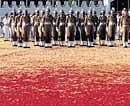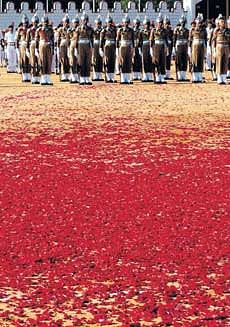
Jana Gana Mana Rann

Hai
Is Rann MeinZakhmi Hua Hai
Bharat Ka Bhaagya Vidhaata
Punjab Sindh Gujarat Maratha
Ek Doosre Se Ladd Ke Mar Rehein Hain
Is Desh Ne Humko Ek Kiya
Hum Desh Ke Tukdey Kar Rahein Hain
Khoon Bahaa Kar
Ek Rang Kar Diya Humne Tiranga
Sarhadon Pe Jung Aur
Galiyon Mein Fasaad Danga
Vindh Himachal Yamuna Ganga Mein
Tezaab Ubal Raha Hain
Mar Gaya Sab Ka Zameer
Jane Kab Zinda Ho Aagey
Phot Bhi Tava Shubha Name Jaage
Tav Shubh Aashish Maange
Aag Mein Jal Kar Cheekh Raha Hai Phir
Bhi Koi Sach Ko Nahi Bachaata
Gahe Tava Jaya Gaatha
Desh Ka Aisa Haal Hain Lekin
Aapas Mein Ladd Rahein Neta
Jana Gana Mangal Daayak Jaya Hai
Bharat Ko Bachale Vidhaata
Jay Hai Yeh Marann Hai
Jana Gana Mana Rann Hai
This is how Sarim Momin interpreted India’s National Anthem for Ram Gopal Varma’s Amitabh Bachchan-starring media world drama Rann. Using major portions of the anthem, the Varma-Momin team wanted to, according to them, interpret the state of affairs in the country.
The Central Board of Film Certification (CBFC) — more commonly known as the Censor Board — thought otherwise. It promptly banned the song.
Varma approached the Supreme Court challenging the Board order, but the court strongly disapproved of the song, with a bench comprising Justice VS Sirpurkar and Justice RM Lodha stating that it gave a “total negative sense” of the anthem, so much so that “it appears that every line of the national anthem has been proved wrong”. It added to good measure, “Nobody has got the right to tinker with the National Anthem.”
That was in May 2009. Finally, in December, Varma replaced the song with an interpretation of Vande Mataram, the National Song. It remains to be seen if this again stokes some controversy in the run up to the release of the film, though Varma has used only the first two words of the song, but this was not the first time that the use of the National Anthem in the audio-visual media created a controversy. One saw it in Karan Johar’s Kabhi Khushi Kabhie Gham and in A R Rahman’s Jana Gana Mana album.
The rendition of the National Anthem of any country is seen by its citizens as the ultimate assertion of their pride of being born in that country, and comes with specified rules and regulations regarding its usage. The controversies around their depiction in the audio-visual media have always erupted from alleged violation of these rules. One prime example of this in recent years was the Sacha Baron Cohen’s parody of the Kazakh National Anthem in his uproariously funny film Borat: Cultural Learnings of America for Make Benefit Glorious Nation of Kazakhstan, because of which the actor was threatened with a lawsuit by the Kazakh government.
The Indian controversies too have not been exceptions, in the case of K3G and Rahman’s album, with people even filing PILs in courts. Varma’s now-aborted interpretation of the Anthem in Rann, in fact, found little support from people at large, even though he claimed to have used the Anthem in a respectful manner for the purpose of artistic expression and said it involved a citizens’ fundamental right to freedom of speech and expression.
On May 6 last year he had said this in defence of the song, “I think the people who are having a problem are in minority and they are not listening seriously to what exactly the song is saying. I have not tinkered with the National Anthem. Tinkering would be if I would have shown it in bad light. I haven’t done anything of this sort. Through this song, we are talking about the disputes in the country but there were no intentions to ridicule anything.”
The CBFC had banned the song’s promo saying it had distorted and tampered with the Anthem. When Varma approached the Apex Court, it refused to grant him any relief, asking him to first approach the Appellate Tribunal set up under the Cinematography Act to challenge the Board decision. Sensing the overall mood, Varma quietly decided to scrap the song.
Of course, before that he and Rann producers Madhu Mantena and Sheetal Talwar sought to raise a further debate on the issue, by sending CDs of the song to all Members of Parliament, a move which Mantena said was to present a correct picture of the whole issue to avoid protests based on hearsay.
In Johar’s case, a scene in which a leading character sings the National Anthem had created a controversy, but the problem had nothing to do with its depiction in the film itself. A Lucknow resident went to the courts demanding action since he found that while the Anthem came on the big screen, only “eight-10 people” stood up in the jam-packed hall. The complainant’s petition was not entertained by the court, but the Jabalpur High Court in Madhya Pradesh, responding to another petition, instructed removal of the scene (interestingly, in the version telecast on TV channels later on, the portion was intact).
Rahman’s album also faced legal hurdles with a petitioner in Madras High Court demanding a ban claiming that the music director was trying to make profit using the Anthem and also that he had violated the singing time stipulation by going on to croon it for six-seven minutes. The court did not find any merit in the petition and dismissed it, saying that it was the right of the citizens to sing the National Anthem and also that there was no provision in the law to punish people for not singing it within the stipulated time. Bharatbala’s Jana Gana Mana film, in which the country’s leading classical musicians sang the Anthem in their unique styles, also faced allegations of violating the Anthem Code.
Quite obviously, while controversies surrounding the National Anthem are not new, when it comes to the audio-visual media, it attracts immense attention. But then, Jana Gana Mana is not new to controversies, with Chandvankar, an avid record collector, even saying that the government-released authorised 78 rpm gramophone record of the anthem, brought out by HMV in 1953, has the word ‘Sindhu’ sung mistakenly as ‘Sindh’, something which has never been rectified!